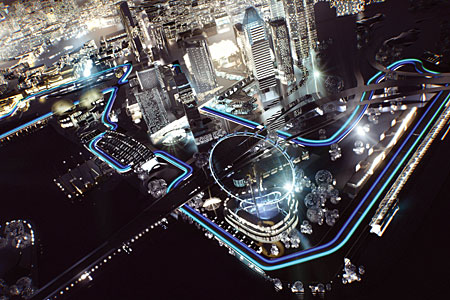That must be some honda civic...
Performance
Grand Prix cars and the cutting edge technology that constitute them produce an unprecedented combination of outright speed and quickness for the drivers. Every F1 car on the grid is capable of going from 0 to 160 km/h (100 mph) and back to 0 in less than five seconds. During a demonstration at the Silverstone circuit in Britain, an F1 McLaren-Mercedes car driven by David Coulthard gave a pair of Mercedes-Benz street cars a head start of seventy seconds, and was able to beat the cars to the finish line from a standing start, a distance of only 3.2 miles (5.2 km).[16]
As well as being fast in a straight line, F1 cars also have incredible cornering ability. Grand Prix cars can negotiate corners at significantly higher speeds than other racing cars because of the intense levels of grip and downforce. Cornering speed is so high that Formula One drivers have strength training routines just for the neck muscles . Former F1 driver Juan Pablo Montoya claimed to be able to perform 300 repetitions of 50 lb (23 kg) with his neck. Since most tracks are clockwise, most drivers have the neck muscles built up on one side of their neck,[citation needed] thus making counter-clockwise tracks (such as Imola, Istanbul Park and Interlagos) a much more testing race than even the high speed Monza or the tight and narrow Monaco.
The combination of light weight (640 kg in race trim for 2011), power (950 bhp with the 3.0 L V10, 730 bhp (544 kW) with the 2007 regulation 2.4 L V8), aerodynamics, and ultra-high performance tyres is what gives the F1 car its performance figures. The principal consideration for F1 designers is acceleration, and not simply top speed. Acceleration is not just linear forward acceleration, but three types of acceleration can be considered for an F1 car's, and all cars' in general, performance:
Linear acceleration (speeding up)
Linear deceleration (braking)
Lateral acceleration (turning)
All three accelerations should be maximised. The way these three accelerations are obtained and their values are:
Acceleration
The 2006 F1 cars have a power-to-weight ratio of 1,250 hp/t (0.93 kW/kg). Theoretically this would allow the car to reach 100 km/h (60 mph) in less than 1 second. However the massive power cannot be converted to motion at low speeds due to traction loss and the usual figure is 2 seconds to reach 100 km/h (60 mph). After about 130 km/h (80 mph) traction loss is minimal due to the combined effect of the car moving faster and the downforce, hence the car continues accelerating at a very high rate. The figures are (for the 2006 Renault R26):[citation needed]
0 to 100 km/h (62 mph): 1.7 seconds
0 to 200 km/h (124 mph): 3.8 seconds
0 to 300 km/h (186 mph): 8.6 seconds*
*Figures are heavily dependent on aerodynamic setup and gearing.
The acceleration figure is usually 1.45 g (14.2 m/s2) up to 200 km/h (124 mph), which means the driver is pushed back in the seat at an acceleration 1.45 times gravity.[citation needed]


